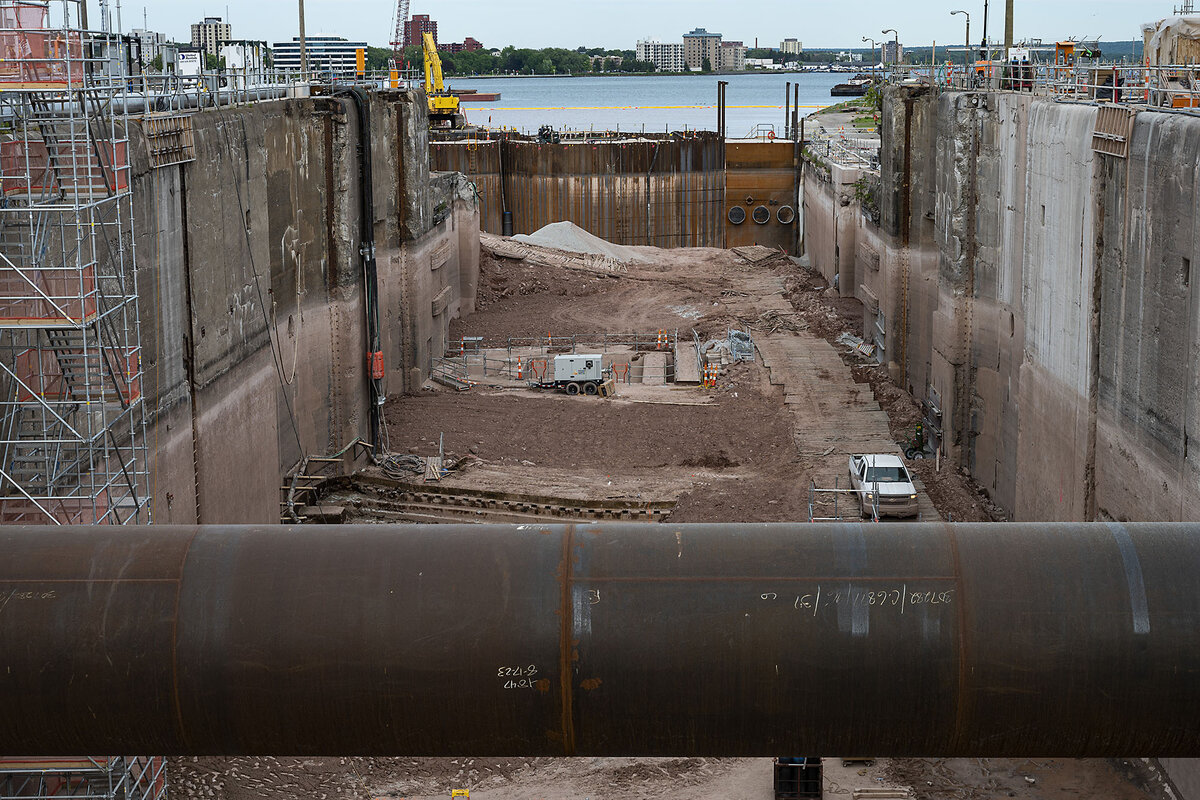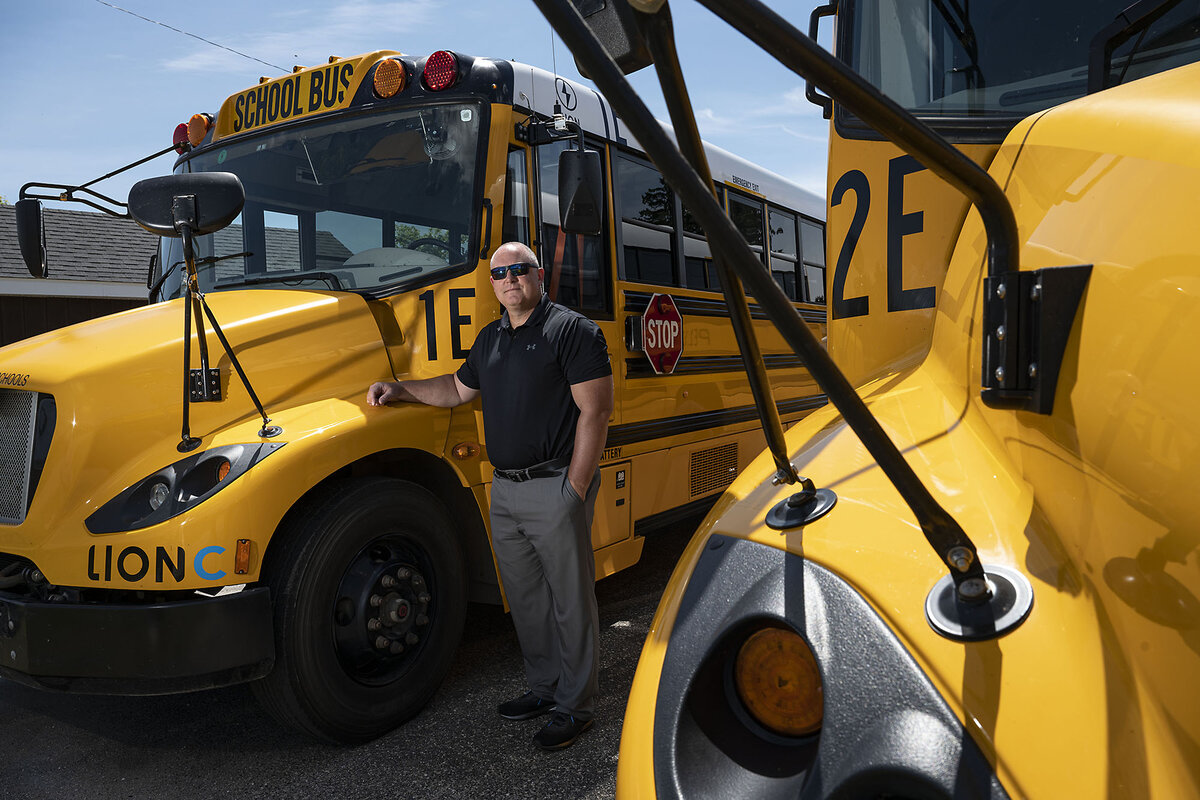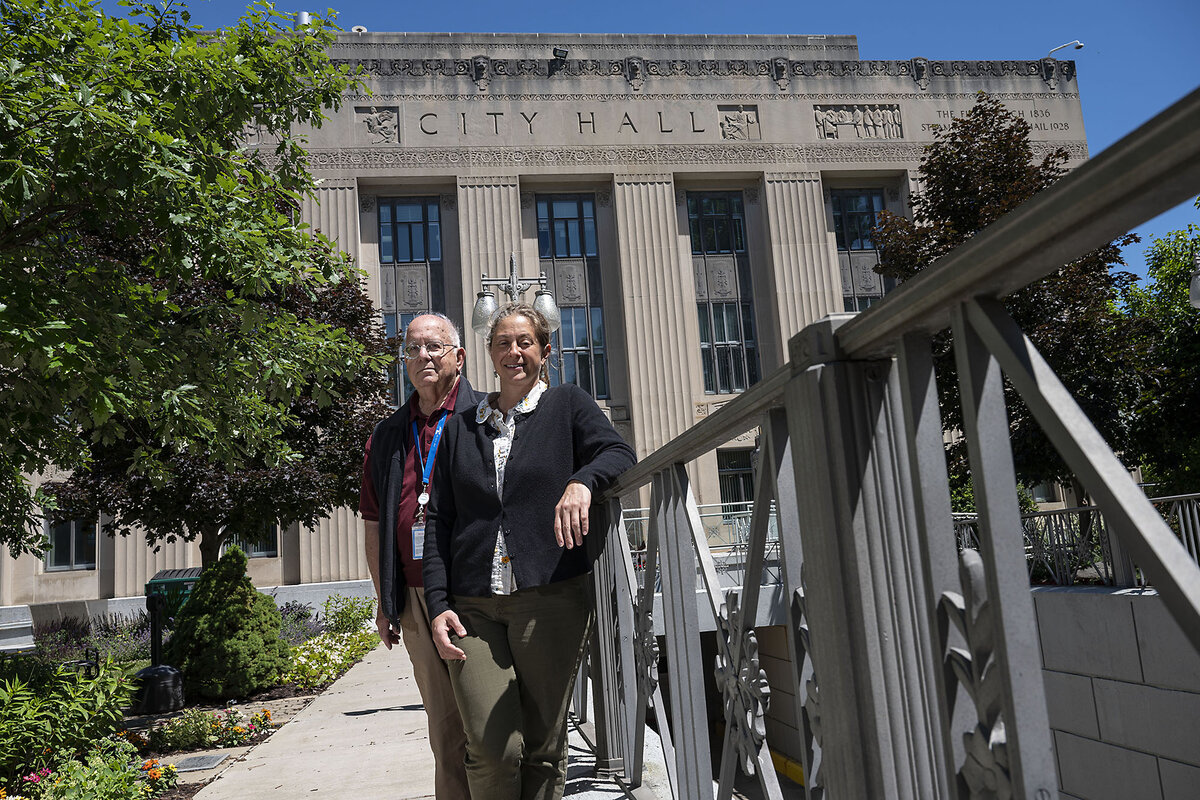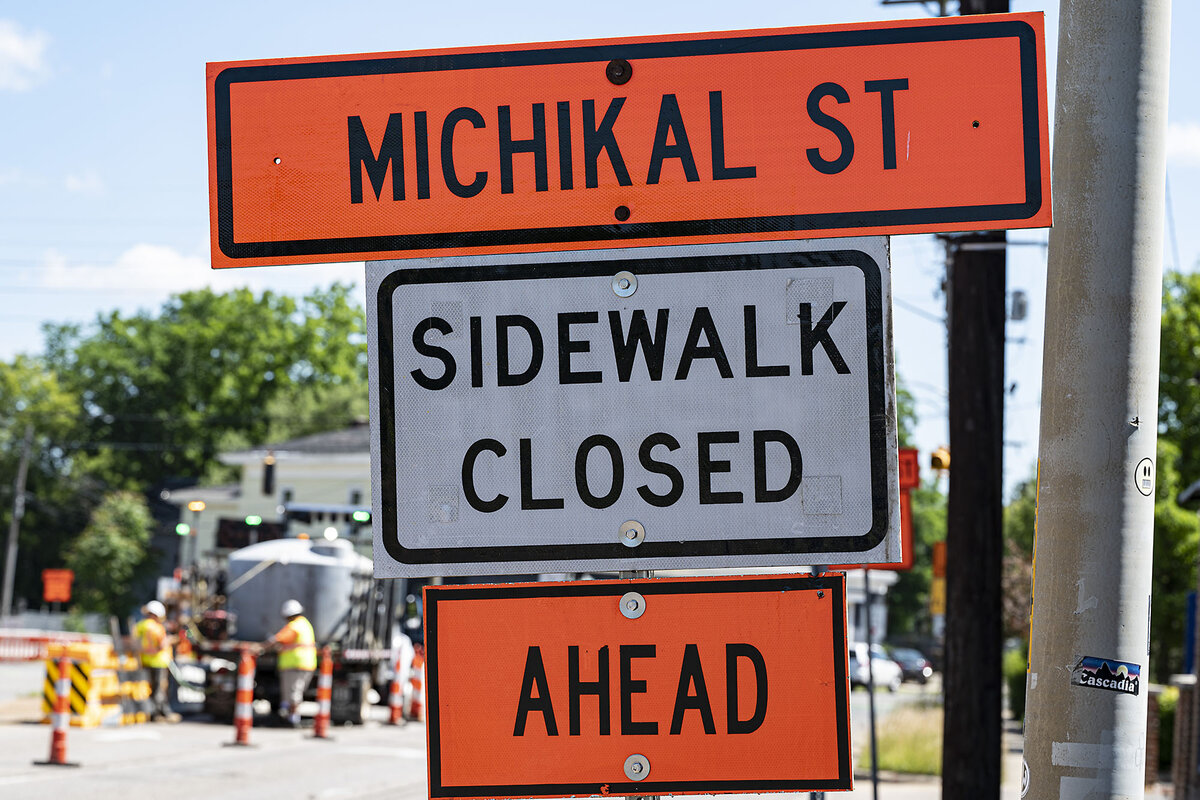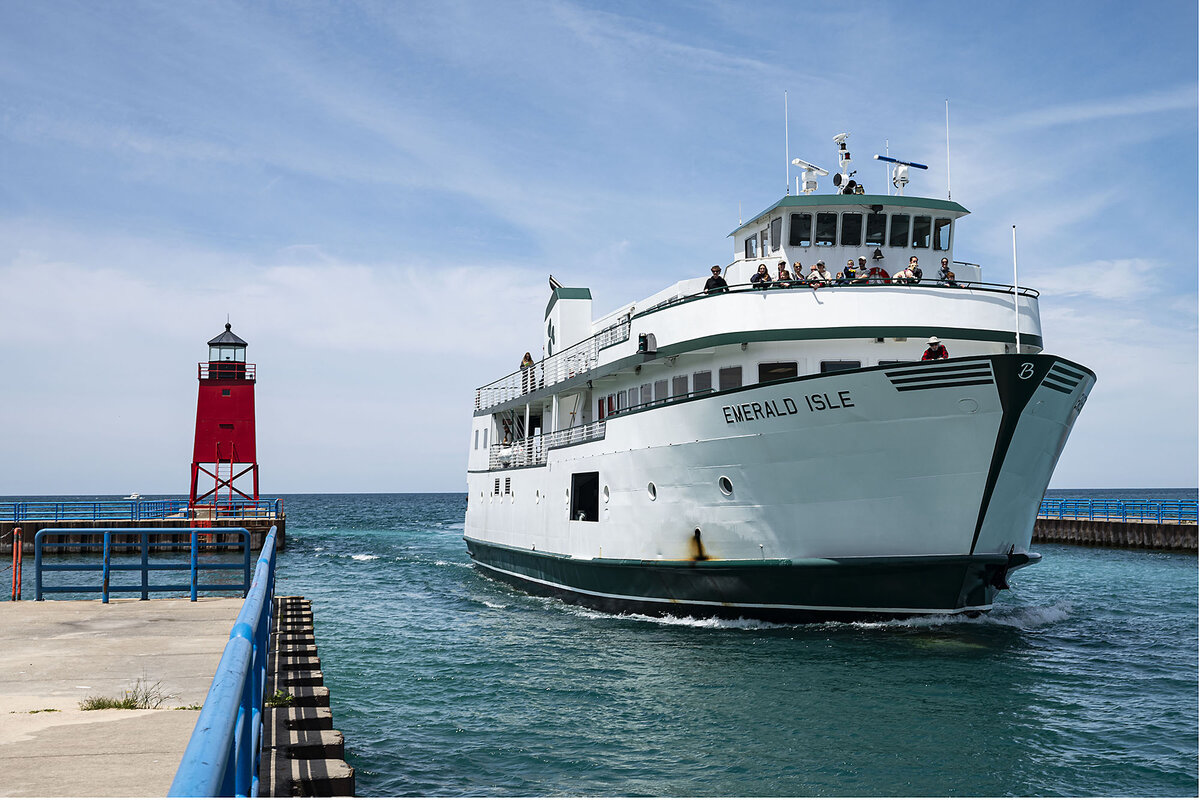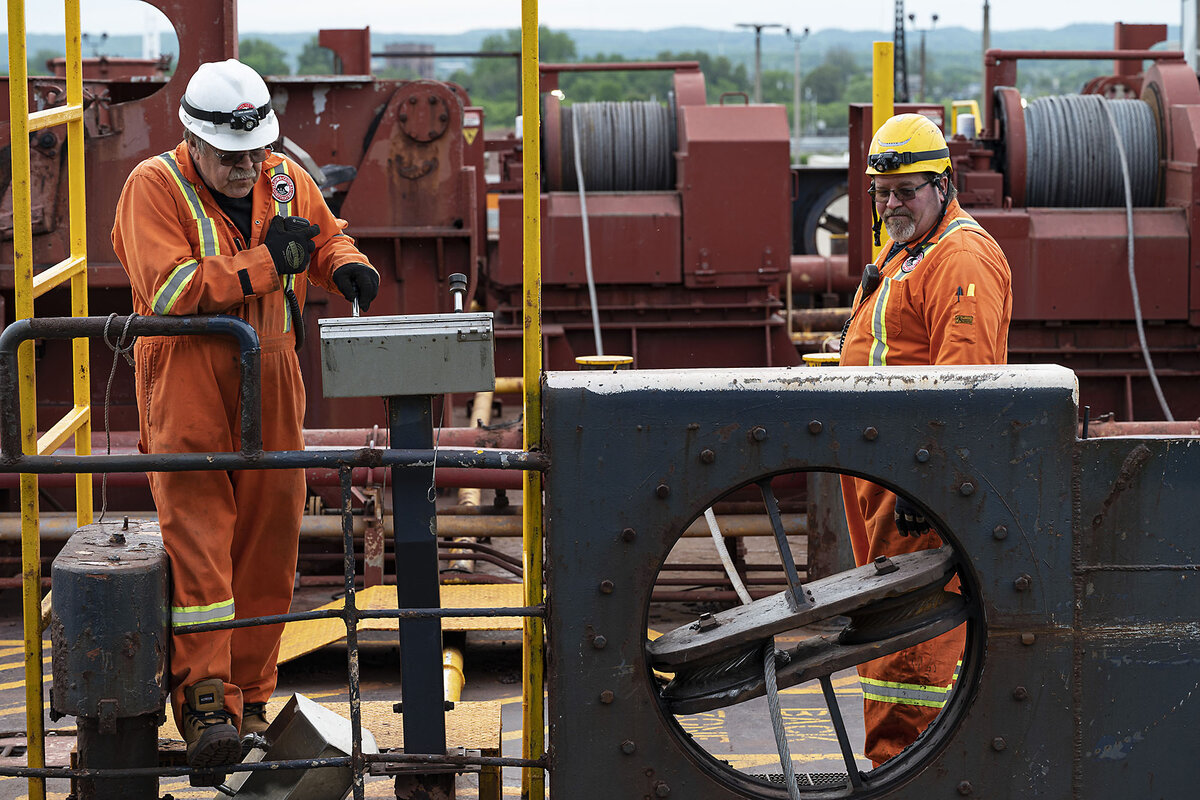Biden poured money into public works. But will that help Harris in Michigan?
Loading...
| SAULT STE. MARIE, MICH.
The new lock has no name.
That will come later. For now, workers in orange vests excavate concrete and dirt from defunct locks built over a century ago in the St. Marys River that divides the United States and Canada. But when they are finished – and 1,000-foot long cargo ships laden with iron ore can rise and fall 20-plus feet in a matter of minutes – there will undoubtedly be a naming ceremony.
Maybe the Biden Lock?
Why We Wrote This
Michigan is a top beneficiary of federal infrastructure funding, but there’s little sign it’s providing a political boost. Part of a series on the issues that may tip key swing states: Arizona, Georgia, Nevada, North Carolina, Pennsylvania, and Wisconsin.
As the “Project funded by President Joe Biden’s Bipartisan Infrastructure Law” poster tied to a nearby fence suggests, the new Soo Lock here in Sault Ste. Marie, Michigan, is spurred by the 2021 legislation that will be a cornerstone of Mr. Biden’s legacy.
Roughly $1.2 trillion is being allocated to projects across the U.S., including $700 million to the Soo Locks complex. It promises a historic surge of job-creating federal investment for roads, bridges, ports, water, and broadband after what experts say has been an era of chronic underfunding.
But the political payoff for Democrats – in Michigan and other critical swing states – may be close to nothing.
For all their tangible promise to the economy and individual lives, the projects funded by the Infrastructure Investment and Jobs Act (IIJA) are by nature long-term efforts. The new Soo Lock, for example, should be done within 10 years. Meanwhile, the election is less than two months away. What voters are more focused on is inflation, which many economic experts agree this legislation contributed to but did not cause.
The campaign politics around some of Democrats’ biggest legislative accomplishments have only gotten more difficult since Mr. Biden dropped out of the presidential race and Vice President Kamala Harris became the party’s presidential nominee. She has tried to cast herself as the “change” candidate, complicating efforts to tout Biden-Harris achievements – including the projects in their infrastructure and inflation reduction acts.
“These two bills would be a landmark achievement for any president, so your instinct is to campaign on it,” says Adie Tomer, a senior fellow at Brookings Metro and an expert on infrastructure policy. “But it runs head first into cold, hard political realities.”
Infrastructure has bipartisan support – to a degree
Infrastructure may be chronically underfunded by Washington, but it is one issue on which Americans on both sides of the political aisle find agreement. At least 70% of Republicans and more than 80% of Democrats favor funding for roads, bridges, and water pipes. (“Who likes lead in their water?” Mr. Tomer asks rhetorically.) When asked about the “Biden infrastructure plan” in a separate poll, however, fewer than 20% of Republicans approve.
With partisanship infiltrating all aspects of U.S. politics, infrastructure isn’t the unifying issue in Congress that it was almost a century ago. Mr. Biden and congressional Democrats, in wanting to signal they can work across the aisle, call the IIJA the “Bipartisan Infrastructure Law.” But while some Republican lawmakers supported it, a majority in both chambers voted against it.
Some of the Republicans who voted no have attended ribbon-cutting ceremonies for these projects, touting the benefits to their districts despite their previous opposition, to the ire of Democrats. And even when completed, these projects haven’t been universally embraced by all constituents.
In northern Michigan, Pellston Public Schools Superintendent Stephen Seelye heard that districts like his – rural, with high poverty and large Native American populations – prequalified for an electric school bus grant through the IIJA. He put in a request and was approved for four new buses late last year worth $375,000 each.
Pellston is one of almost 1,300 school districts in the U.S. that have been awarded almost 9,000 school buses through the Environmental Protection Agency’s Clean School Bus Program, a $5 billion slice of the IIJA.
Given that transportation costs per student are higher in rural districts, Pellston expects to save $50,000 a year as the electric buses reduce fuel and maintenance costs. For a district where 22% of children under 18 years old live in poverty, that kind of money is “huge,” says Mr. Seelye, as he leans against the hood of one of his new yellow buses, glittering in the afternoon sun. “That’s close to the cost of a teacher.”
But when the news was announced on Facebook, “the negative comments were crazy,” he says. “We’re in a very Republican area, so there was a lot of heat for putting these buses on the road.” He attributes the pushback from his community, where former President Donald Trump won by double digits, to the fact that “electric” has become a liberal buzzword, and that the source of funding is “a Biden thing.”
The criticism has died down now that Pellston has seen the buses in action, says Mr. Seelye. Drivers rave that their new vehicles handle the wintry roads far better, and they appreciate how the buses can be programmed to preheat ahead of time.
The district just got funds for its fifth and final bus to be traded for an electric one as well.
Without the federal funding, it would have taken a decade to replace the fleet. (The district was replacing one traditional school bus, each costing about one-third as much as an electric bus, every two years.)
In Kalamazoo, a faster road forward
Other local officials across Michigan say the IIJA cash influx is expediting projects that had previously been put off.
“The infrastructure bill has allowed us to do some catch-up and accelerate our work significantly,” says Dennis Randolph, a traffic engineer for the city of Kalamazoo, Michigan, about 250 miles south of Pellston.
“And we’re also able to do the work better,” adds Kalamazoo city planner Christina Anderson.
Kalamazoo received over $12 million through the IIJA’s Reconnecting Communities and Neighborhoods Grant Program, which was created to redesign transportation systems that had cut through and disrupted minority neighborhoods in a form of racial discrimination. Two multilane, one-way roadways – Kalamazoo and Michigan avenues – are in the process of becoming two-lane streets with parking, bike paths, and pedestrian walkways.
As they drive around Kalamazoo in Mr. Randolph’s car, the two officials point out how the redesign will benefit the whole city. Locals in this majority Black neighborhood will be able to drive into town more easily without having to go in one-way circles, says Mr. Randolph. College students on the city’s west side will be able to safely cross the streets, says Ms. Anderson. A creekside walking path will be created near Michikal Street.
Without the IIJA funding, these projects would probably have taken Kalamazoo two decades to complete, says Mr. Randolph. Now they expect all of the work to be done by 2032.
But today, the city’s downtown is a mess of cones, detours, and angry drivers’ horns.
“Not only is infrastructure not always super sexy or flashy, but there is short-term pain associated with it,” says Ms. Anderson, gesturing to the “STREET CLOSED” signs in seemingly all directions.
“But there are also jobs associated with it, and material usage, and all sorts of other things that are positive for the economy,” she continues. “Which is why infrastructure often gets lifted up during times of economic challenge, and has forever in America’s history.”
Rural broadband: echoes of the New Deal
Mr. Biden has invited comparisons between himself and President Franklin Roosevelt throughout his term, including in his State of the Union address earlier this year. The White House has compared the IIJA’s broadband program to the Rural Electrification Act, part of Mr. Roosevelt’s New Deal response to the Great Depression.
Michigan is getting one of the largest allocations from the IIJA’s Broadband Equity, Access, and Deployment program, which commits $42 billion to help homeowners who have been underserved by private providers because of their income or geography. The goal is to have all of America connected by 2030. But funding won’t reach specific projects until next year.
Another political challenge for Democrats: Voters often assume that things like smoother roads or better school buses are in the purview of local officials.
“Infrastructure is typically not a leading priority issue for voters, especially in a presidential [race],” says Mr. Tomer of Brookings Metro. A July survey from Gallup tracking top issues found that 33% of voters ranked economic issues as the most important issue facing the country, followed by “poor leadership” at 26%, and immigration at 19%. Infrastructure didn’t register in the poll, falling below 1 percentage point.
In many cases, these projects are seen as below the jurisdiction of statewide officials, which is partially what made Michigan Gov. Gretchen Whitmer’s winning gubernatorial campaign slogan in 2018 to “Fix the damn roads” so catchy.
But as Governor Whitmer soon found out, infrastructure projects can quickly become prohibitively expensive. Ms. Whitmer is now relying on IIJA funds to help fulfill her campaign promise. In turn, the IIJA’s conservative critics say such massive federal spending will inevitably involve waste, and burden the economy by adding to an already high federal debt.
In Michigan and beyond, maintenance deferred
Michigan is one of the top 10 states for IIJA funding – which makes sense, says Zachary Kolodin, director of the Michigan Infrastructure Office, given the state’s history. Between 1910 and 1960, Michigan’s population more than doubled, outpacing the overall U.S. growth rate. “Because that boom happened almost a century ago,” he says, “much of that infrastructure is considered aging.”
But here and in other U.S. states, repairs have been put off, because of price tags and the incentive for politicians to focus on immediate rather than long-term outcomes.
The collapse of Baltimore’s Francis Scott Key Bridge in March drew nationwide attention, for example, and although the collapse was caused by a collision involving a cargo ship, engineers say the bridge’s age played a role. According to the American Society of Civil Engineers, 46,000 U.S. bridges are “structurally deficient.” The society’s 2021 report card of American infrastructure (which gave the country a C-, its highest grade in 20 years) found that it would take until 2071 to make all of America’s necessary bridge repairs at the rate of investment prior to the IIJA.
Two days after the collapse, the Biden administration released a “down payment” (not from IIJA) to help with repairs.
“It’s been incredibly frustrating that we only think of infrastructure when it doesn’t work,” says Scott Berry, director of policy at the U.S. Water Alliance. “It’s truly difficult to quantify what a political success this bill is.”
How much good or harm for U.S. economy?
When the IIJA expires in 2026, whichever party wins control of Congress will decide how to fund these programs, or whether they will revert to previous funding levels.
So far less than half of the $1.2 trillion has been announced for specific projects. But the pace has picked up in recent months, as Biden officials know that designated funds are much more difficult to claw back if Republicans win majorities on Capitol Hill in November.
Some in the GOP have slammed the projects as inflationary, but the law’s true effect on inflation is “modest at best,” says Kent Smetters, an economics professor at The Wharton School of the University of Pennsylvania. He’s director of The Penn Wharton Budget Model, which estimates that the IIJA only added 0.1% to 0.2% to the current inflation rate.
That’s largely because the bill’s price tag isn’t actually $1.2 trillion, he adds. Only about half is really new funding; the rest is what the federal government would typically spend on infrastructure.
“This is one of those issues where the extremes on both sides are wrong,” says Professor Smetters, who doesn’t see the IIJA having a large negative or positive effect on the economy.
One factor: Some of these projects – like the new third lock at Sault Ste. Marie – were going to happen anyway. The new lock was first authorized by Congress in 1986, though construction didn’t actually begin until 2020. Now, the IIJA funding will allow the Army Corps of Engineers to “stay on schedule,” says Mollie Mahoney, senior project manager for the lock.
That’s important, because only two Soo Locks – the Poe and the MacArthur – are currently in operation. (Two other century-old locks were decommissioned in 2010.) The new lock will allow the Army Corps to take the Poe offline for repairs – a vital next step because the Poe is over its 50-year design life. Without the new, third lock, closing the Poe would halt 75% of U.S. steel production, according to a 2015 study by the Department of Homeland Security. “In terms of an impact to the North American economy, it is hard to conceive of a single asset more consequential than the Poe Lock,” concluded the report. Not to mention the impact such a closure would have on northern Michigan.
“Being federal employees, we look at things from a very national perspective,” says Rachel Miller, the new lock contracting officer’s representative. “But it’s also a central part of the community. In Sault Ste. Marie, the locks are the thing here.”
In the evening, horns sound as the MacArthur Lock opens its gates for the Algoma Discovery – a Canadian vessel carrying 25,000 tons of iron ore from Minnesota to Canada. After entering the lock at Lake Superior’s water level, the ship drops 1 foot per minute for 21 minutes, with the lock draining 22 million gallons of water to reach the level of Lake Huron.
As a Canadian employee on the top deck slowly falls to eye level, his eye catches my notebook. He asks what I am taking notes about, and I tell him I’m in Sault Ste. Marie to report on the new lock. The Canadian nods, saying he’s heard about it in his country, on the other side of the river.
“Wasn’t that a campaign promise from Trump?” he asks, before the boat blows its horn to exit the lock.
This is one of a seven-part series on key swing states in the U.S. presidential election and the issues that may tip them. The full series includes articles reported from Arizona, Georgia, Michigan, Nevada, North Carolina, Pennsylvania, and Wisconsin.






